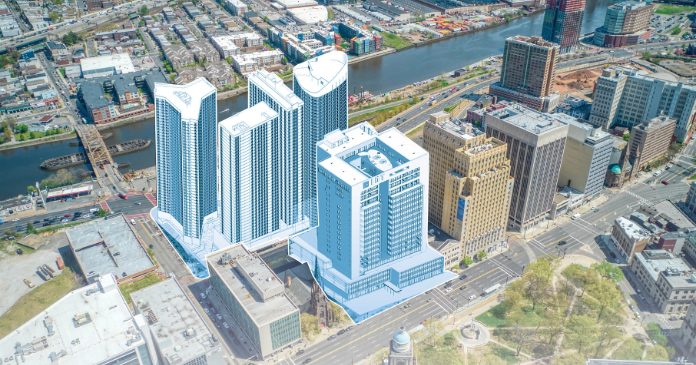The Alliance was formed in 2006 by Newark residents Hassan Keith and Jeffrey Montgomery and Buffalo, New York, native Victor Baker. The principals, who met while attending Rutgers University, each bring to the company a core competency. Baker, who worked in the securities business, has been instrumental in securing the private capital necessary for development projects through his investment industry connections. With more than 10 years experience in the Newark market, Keith is a general contractor and principal of Homework’s Construction LLC, a certified minority business enterprise. Montgomery is a real estate investor who holds and manages rental housing for Section 8 rentals in the city.
“Keith and Montgomery had gotten into the rehab market in Newark, buying old, distressed properties, rehabbing them and returning them to the market as rentals, to the subsidized-housing tenancy,” said Baker, who later joined his fellow alums in that business. “Hassan wanted to segue into Newark’s new development landscape. I had purchased, rehabbed and sold a number of properties in Newark and I had quite a few connections when I stepped into the market,” he said.
The trio began to pursue new development opportunities and put packages together and submitted them to the city, even before Booker came into office.
“We were trying to get involved during Sharpe James’ administration and that was pretty tough. We didn’t get much done,” Baker said.
Still, two lots were designated to their group under James, but, when Booker took over as mayor, a land injunction went into effect and development was frozen for a year.
“We were able to transition with the new administration and put together a five-parcel development opportunity, which was designated for affordable housing. We closed on the land during the Booker administration,” Baker said.
The city sold the land, a total of 14,300 sq. ft., to the Alliance for $56,800 in exchange for the group’s agreement to build affordable housing and take less profit on the sale of the homes. A platform, which ultimately was modified as subsidy dollars from the State of New Jersey became a part of the deal, dictated new and actually more profitable terms for the developer. Designated by the state agency, New Jersey Housing and Mortgage Finance Agency (NJHMFA), in conjunction with their partner and co-lender Community Preservation Corporation, prices for two of the workforce homes will be $349,000 and the other two will be priced at $363,000, closer to market-rate but still below the average area median price of a two-family home, which in Essex County is $500,000, said Baker.
Mid-Atlantic also has the support of the Bogolan Community Development Initiative, a New York City-based non-profit that intends to offer the development’s middle-income buyers substantial down-payment grants. The grants are anticipated to reduce the mortgage on the four workforce homes to less than $300,000 apiece.
The affordable home will be sold to low-income buyers for $126,000 and comes with a 10-year deed restriction. If the buyer sells the home before the end of the restriction period, they must repay the state all, or a portion of the difference between what they paid and the market value of the property, which Baker estimates is around $310,000, even in today’s down market.
The homes will be modern and much-improved versions of the Bayonne- style house prevalent throughout Newark’s neighborhoods – a two-family- style home that allows owners to subsidize their mortgage by renting out the second units. “Our homes adhere to a new design standard implemented by Newark Director of Planning Tony Griffin. They will sit close to the curb and have an owner’s duplex unit on the first two floors and a rental unit on the third, whereas the Bayonne houses were deeper within a slightly larger lot and had a garage on the ground floor and two units above,” said Baker.
The new homes’ eco-friendly features include high-efficiency furnaces and air conditioning systems, bamboo flooring and wool carpeting, low- e windows and low VOC paint.
Baker said the $2 million project would never have come to fruition if he hadn’t secured a $400,000 subsidy through New Jersey’s Home-ownership Incentive Fund CHOICE program. Construction financing for the project includes two equal amounts of $607,163 from the Community Preservation Corporation, a not-for-profit mortgage lender that finances residential multifamily development throughout New York, New Jersey and Connecticut, and the NJHMFA.
He and his partners in the Alliance would like to participate in the city’s Vacant and Abandoned Properties pilot programs, but are unsure where the financing would come from for those affordable projects. “It would not be financially feasible to do affordable housing without subsidy. With that said, the municipality has done a fantastic job of conveying the land at a reasonable price of $4 per sq. ft. – I applaud them for that. But these city-owned lots are blighted. They are not delivering any taxes. We need more subsidies for this type of scattered neighborhood development, or these neighborhoods will remain blighted for years,” he said.
Baker also would like to see less bureaucratic excess. “Ours is a three-year-old project and projects can take years to come to fruition. But a project this small shouldn’t take this long to go through the municipality and secure planning board approvals, council votes and hearings. I have private capital anxious to come into the market, but hesitation arises when bureaucracy holds up a project for two or three years and the subsidies aren’t there to make it profitable. But then, maybe that sentiment is echoed across the country,” he said.
















